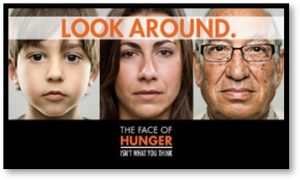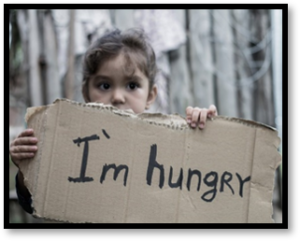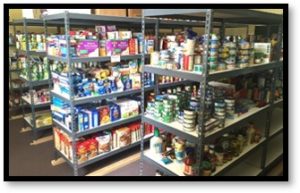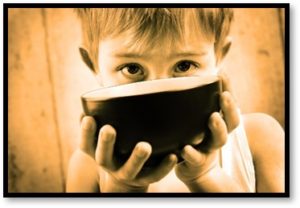Monday Author: Susanne Skinner
“If you can’t feed a hundred people, feed just one.” ~ Mother Teresa
Thanksgiving is in our rear-view mirror and it’s full speed ahead to holiday decorating, party planning and continued good eating.
But not everyone celebrates with a bountiful table, stocked pantry and full belly. Hunger in America is nation-wide. More than 42 million people, or about 19% of the United States population, fall below the federal poverty line, and 13 million of them are children. These numbers do not include the homeless.
What is Poverty?
The term poverty identifies individuals earning less than $25,750 per year, the minimum amount of money a family needs to afford food, clothing, shelter and transportation. In middle class households where all the adults are employed, it is called working poverty.
In addition, the U.S. Census Bureau defines deep poverty as a family with a total cash income below 50 percent of the poverty threshold. Those in deep poverty represent 5.8% of the total population and 45.6% of those already living in poverty.
People living in poverty do not have enough to eat. Approximately 22% of the U.S. population participates in government assistance programs that supply food. The cost of hunger is increasing, affecting the economy through the health care system, the justice system and state and local support services. Everyone pays for hunger.
The Face of Hunger
When we picture hunger, we see third-world countries and depression-era food lines. We do not think of Americans living in houses, decently clothed, employed, and married.
 People who look like you and me are the new the face of hunger. They are the working poor, juggling multiple jobs and double shifts, eating fast food and living in communities with limited full-service grocery stores. Healthy food is harder to find and its more expensive. Those affected lack the resources to eat well on a reduced income.
People who look like you and me are the new the face of hunger. They are the working poor, juggling multiple jobs and double shifts, eating fast food and living in communities with limited full-service grocery stores. Healthy food is harder to find and its more expensive. Those affected lack the resources to eat well on a reduced income.
The trade-off between food that is filling and food that is nutritious is obesity. Going hungry in America includes the side effect of weight gain due to a poor diet, combining lack of quantity with inadequate quality.
Food Insecurity
Food insecurity describes a household’s inability to provide enough food for every person to live an active, healthy life. It is one way to measure and assess the risk of hunger. In the United States, one in nine people struggle with hunger, and one in four of them are children. That means you probably know someone who does not have enough to eat.
 People who fail to qualify for federal nutrition assistance depend on food banks to make ends meet. The Feeding America network supports nearly every community in the United States, serving more than 40 million people, including 12 million children and 7 million seniors.
People who fail to qualify for federal nutrition assistance depend on food banks to make ends meet. The Feeding America network supports nearly every community in the United States, serving more than 40 million people, including 12 million children and 7 million seniors.
Chronic hunger has a tangible impact on well-being, including declining health, lower productivity and higher medical costs. In adults, poor nutrition leads to obesity, diabetes, heart disease, depression and fatigue. The effect of food insecurity on children includes low birth weight, frequent illness and delayed cognitive development.
The Impact of Not Enough Food
The United States produces far more food than it needs for domestic consumption, making us question how people go hungry. The answer may surprise you—it is mostly due to food waste.
Despite the fact that over 42 million people live in food-insecure households, Americans throw out an estimated 80 billion pounds of food every year, or $640 per household.
 In the United States, food waste is between 30% to 40% of the food supply. Excess food distribution is inefficient and improving access to those who need it most is critical.
In the United States, food waste is between 30% to 40% of the food supply. Excess food distribution is inefficient and improving access to those who need it most is critical.
Lay-offs, unexpected expenses, medical issues, and job-related accidents force families to decide between buying food and paying bills. The poverty line family is at risk for all these situations; resulting in the inability to put food on the table.
The young and the old are especially vulnerable. Sending a child to school hungry damages their ability to learn and grow. Seniors living on fixed incomes are choosing between food and necessary healthcare.
Food Assistance
Food pantries, soup kitchens, food banks, and food rescue organizations offer private assistance to those in need. In 1980, there were fewer than 300 emergency food programs; today there are over 100,000.
A food bank is a non-profit organization collecting and distributing food to hunger-relief charities. Food banks serve as storage and delivery centers for smaller front-line agencies; they do not give food directly to individuals.
 Food banks in the U.S. are very diverse, ranging from small operations spread across large rural areas to urban facilities storing and distributing millions of pounds of food.
Food banks in the U.S. are very diverse, ranging from small operations spread across large rural areas to urban facilities storing and distributing millions of pounds of food.
Multiple factors affect how food banks work, from the size of the building to the number of support staff. One thing all assistance programs have in common is the reliance on donors and volunteers to carry out day-to-day operations.
Food banks distribute to food pantries and they in turn offer items to people in the community. Non-profit organizations manage and staff food pantries; receiving, buying, and allocating food. They must comply with local, state and federal laws for food safety.
Hunger is Everyone’s Problem
No matter how we define poverty, it’s an issue worthy of everyone’s attention. Local food assistance organizations welcome donations throughout the year, but December reminds us to be generous in our giving, sharing something as basic as food.
 Your local food assistance organization keeps a list of needed supplies. There are numerous items not covered by supplemental aid and these contributions are especially meaningful during the holidays.
Your local food assistance organization keeps a list of needed supplies. There are numerous items not covered by supplemental aid and these contributions are especially meaningful during the holidays.
My church is participating in a reverse advent calendar, benefiting our local food pantry, The Cape Coral Caring Center. Every contribution makes a difference in someone’s life.
Celebrations revolve around food. Share your blessings with those in need.

